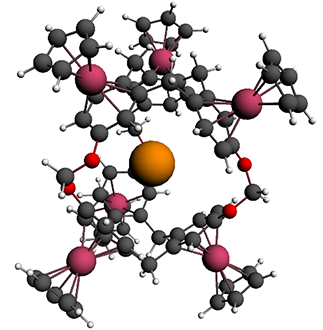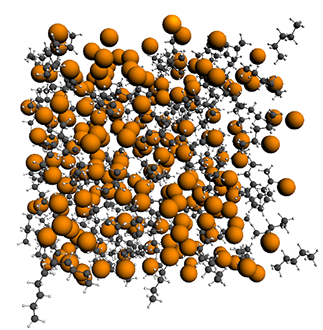ZORA DFT explains subtle 129-Xe NMR parameters
Xenon-129 NMR is a powerful technique to probe the characteristics of of surfaces, porous media and solutions, because of its extreme sensitivity to external perturbations. Accurate calculations can help to interpret experimental results which are otherwise difficult to understand.
In two recent publications Prof. Bagno (Padova University) and Dr. Saielli (ITM-CNR) have shown that with relativistic DFT in ADF, NMR properties of xenon involved in non-covalent interactions can be accurately predicted. The researchers reproduced and analyzed the dramatic deshielding of Xe upon encapsulation in a ruthenium-functionalized cryptophane (Δδobs = 277 ppm, Δδcalc = 281 ppm). In another study, together with experimentalists from Princeton, the first observation of spin-spin coupling originating from van der Waals interactions was reported for a Xe/pentane mixture. The molecular dynamics averaged ZORA DFT calculations agreed well with the experimental SQUID measurements, both at 173 K (JXe-H = -2.7 ± 0.6 Hz, calculated = -3.2 Hz).


129Xe NMR parameters are sensitive to their environment even if no through-bond interactions exist. Xe is strongly deshielded in this cryptophane shown on the left, and for the first time through-space spin-spin coupling (Xe-H) has been shown for the Xe/pentane mixture on the right. Both experimental results are well reproduced and understood through relativistic DFT calculations with ZORA.
See also the walk-through example for relativistic NMR calculations and the NMR settings FAQ.
A. Bagno, G. Saielli, Understanding the extraordinary deshielding of 129Xe in a permetallated cryptophane by relativistic DFT. Chem. Eur. J. 18, 7341-7345 (2012)
M. Ledbetter, G. Saielli, A. Bagno, N. Tran, M. V. Romalis, Observation of scalar nuclear spin-spin coupling in van der Waals complexes. Proc. Natl. Acad. Sci. USA 109, 12393-12397 (2012)